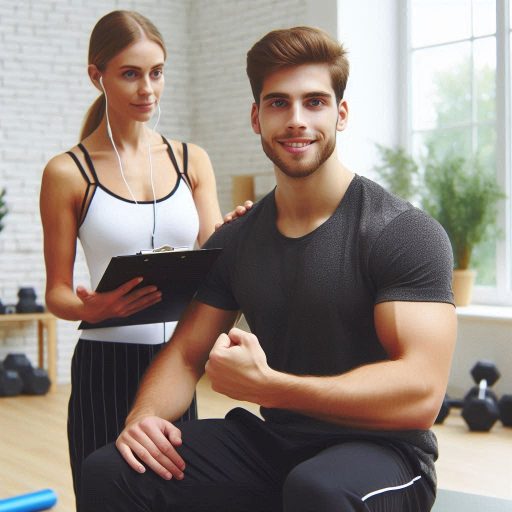Introduction
Having the right equipment is crucial for personal trainers to deliver effective training sessions.
Proper equipment can enhance client experiences by providing variety and accommodating different fitness levels.
Must-Have Equipment for Personal Trainers
- Dumbbells: Essential for strength training exercises to target different muscle groups effectively.
- Resistance Bands: Versatile tools for adding resistance to bodyweight exercises and improving flexibility.
- Stability Balls: Great for core exercises, balance training, and rehabilitation workouts.
- Kettlebells: Ideal for full-body workouts, combining strength, cardio, and flexibility training.
- Jump Ropes: Effective for cardiovascular workouts, agility training, and improving coordination.
- Foam Rollers: Useful for self-myofascial release, reducing muscle tension, and improving flexibility.
- TRX Suspension Trainer: Perfect for bodyweight exercises, offering endless variations and challenging workouts.
Additional Equipment for Advanced Training
- Medicine Balls: Great for power and functional training, providing dynamic and explosive movements.
- Battle Ropes: Excellent for full-body workouts, improving strength, endurance, and cardiovascular fitness.
- Plyometric Boxes: Essential for plyometric training, enhancing power, speed, and agility.
- Agility Ladders: Ideal for improving footwork, speed, agility, and coordination.
- Cones and Markers: Useful for setting up circuits, agility drills, and enhancing coordination skills.
Equipping yourself with the right tools as a personal trainer is vital for creating diverse, challenging, and effective workout programs.
Investing in a variety of equipment can cater to different client needs, enhance training experiences, and maximize results.
Dumbbells and Barbells
When it comes to essential equipment for personal trainers, dumbbells and barbells are at the top of the list.
These versatile tools are key in strength training and can be utilized in a variety of ways to help clients achieve their fitness goals.
Versatility of Dumbbells and Barbells
Dumbbells and barbells can be used for a wide range of exercises, including compound movements like squats, deadlifts, bench presses, and shoulder presses.
They can also be used for isolation exercises to target specific muscles, making them perfect for both full-body workouts and muscle-specific training.
Different Weights and Sizes
Personal trainers should have a selection of dumbbells and barbells in different weights to cater to clients of all fitness levels.
Having a range of sizes allows trainers to gradually increase the intensity of exercises as clients progress in their strength and endurance.
Benefits of Using Dumbbells and Barbells
Using dumbbells and barbells for functional movements helps improve coordination, balance, and overall muscular strength.
These tools engage stabilizer muscles, promoting better muscle development and reducing the risk of injury during workouts.
Overall, incorporating dumbbells and barbells into training sessions can enhance the effectiveness of workouts and maximize the results for clients.
Personal trainers who have these essential tools in their arsenal are better equipped to design customized programs that meet the unique needs of each individual.
Read: How to Price Your Personal Training Services Competitively
Resistance Bands
One essential piece of equipment that every personal trainer should have in their arsenal is resistance bands.
These versatile tools offer a wide range of benefits for both trainers and clients alike.
Importance of Incorporating Resistance Bands
Resistance bands are a great way to add variety and challenge to workouts.
They can help target specific muscle groups, improve overall strength, and enhance flexibility and mobility.
By incorporating resistance bands into workouts, trainers can keep sessions interesting and engaging for clients.
Transform Your Career Today
Unlock a personalized career strategy that drives real results. Get tailored advice and a roadmap designed just for you.
Start NowBenefits of Using Resistance Bands
Resistance bands offer a unique form of resistance that is different from traditional weights.
They provide a constant tension throughout the entire range of motion, helping to strengthen muscles and improve stability.
Additionally, resistance bands are portable and easy to use, making them ideal for both in-person and online training sessions.
Examples of Exercises with Resistance Bands
- Squat with Resistance Bands: Place the band around your thighs or above your knees to add resistance to your squats and target your glutes and quads.
- Bicep Curls with Resistance Bands: Step on the band and curl your arms up, engaging your biceps and forearms.
- Shoulder Press with Resistance Bands: Stand on the band and press it overhead, targeting your shoulders and triceps.
- Clamshells with Resistance Bands: Loop the band just above your knees and perform clamshell exercises to activate your hip abductors.
- Leg Raises with Resistance Bands: Secure the band around your ankles and perform leg raises to strengthen your hip flexors and core.
These are just a few examples of the many exercises that can be done with resistance bands.
Personal trainers can get creative and customize workouts to meet the specific needs and goals of their clients.
Overall, resistance bands are a valuable tool for personal trainers to have in their toolkit.
By incorporating resistance bands into workouts, trainers can help clients improve their strength, flexibility, and mobility in a safe and effective manner.
Read: How Personal Trainers Customize Workout Plans for Clients
Stability Balls
Stability balls are essential equipment every personal trainer should have in their arsenal.
These versatile tools offer a wide range of benefits for clients looking to improve their core strength, balance, and overall fitness.
Benefits of Using Stability Balls
- Core Strengthening: Stability balls provide an unstable surface, forcing clients to engage their core muscles to maintain balance during exercises.
- Improved Balance: Training on a stability ball helps improve balance and proprioception, which are crucial for everyday movements and preventing injuries.
- Versatile Workouts: Stability balls can be used for a variety of exercises targeting different muscle groups, making them a valuable addition to any workout routine.
Targeting Different Muscle Groups
- Core: Stability balls are great for targeting the abdominal muscles, obliques, and lower back through exercises like crunches, planks, and Russian twists.
- Upper Body: Clients can perform push-ups, shoulder presses, and tricep dips on stability balls to strengthen their arms, shoulders, and chest muscles.
- Lower Body: Squats, lunges, and hamstring curls can be done on stability balls to work the quadriceps, hamstrings, glutes, and calves.
Selecting the Right Size Stability Ball for Clients
Choosing the correct size stability ball is crucial to ensure clients can perform exercises safely and effectively.
Here are some tips for selecting the right size:
- Height: Clients should be able to sit on the ball with their feet flat on the ground and knees at a 90-degree angle.
- Size Guide: Use a sizing chart to match the client’s height to the corresponding stability ball size (e.g., 55 cm for individuals under 5’4″ and 65 cm for those between 5’4″ and 5’11”).
- Inflation: Inflate the stability ball to the proper size based on the manufacturer’s recommendations to ensure it’s firm enough for exercises.
By incorporating stability balls into your training sessions, you can help clients improve their core strength, balance, and overall fitness.
Remember to guide them through proper form and technique to maximize the benefits of using stability balls in their workouts.
Read: Best Certifications for Personal Trainers in the USA

Kettlebells
Kettlebell training offers a unique combination of cardiovascular fitness and strength benefits.
It is a versatile tool that can be used in a variety of ways to enhance workouts and improve overall fitness levels.
Unique Benefits of Kettlebell Training
- Combines cardiovascular and strength training
- Improves grip strength and posture
- Enhances core stability and balance
- Increases overall endurance and power
Weights and Sizes of Kettlebells
When it comes to choosing kettlebells for your training sessions, it’s important to have a variety of weights and sizes to accommodate different fitness levels and exercise requirements.
- 8-12kg for beginners
- 12-16kg for intermediate level
- 16-24kg for advanced level
- 24kg+ for elite athletes
Kettlebell Exercises for Workouts
There are numerous kettlebell exercises that can be incorporated into workouts to target different muscle groups and improve overall strength and endurance.
Here are some examples:
Transform Your Career Today
Unlock a personalized career strategy that drives real results. Get tailored advice and a roadmap designed just for you.
Start Now- Kettlebell swings
- Kettlebell goblet squats
- Kettlebell Turkish get-ups
- Kettlebell snatches
- Kettlebell windmills
By including kettlebells in your equipment collection, you can add a dynamic and effective element to your training sessions, helping your clients achieve their fitness goals faster and more efficiently.
Read: How to Expand Your Personal Training Services
Foam Rollers
Importance of foam rolling for muscle recovery and injury prevention
Foam rollers play a crucial role in muscle recovery and injury prevention.
They help alleviate muscle soreness after workouts and improve flexibility.
Foam rolling enhances blood circulation, which promotes faster recovery.
By incorporating foam rolling into your clients’ routines, you can reduce their risk of injuries.
Different types of foam rollers available and their specific benefits
Various types of foam rollers are available, each with unique benefits.
Standard foam rollers are versatile and suitable for beginners.
They offer gentle pressure for general muscle relief.
High-density foam rollers provide deeper tissue massage and are ideal for more experienced users.
These rollers target tight muscles effectively. Trigger point foam rollers feature ridges and bumps.
They focus on specific muscle knots, delivering intense relief.
Consider your clients‘ needs when choosing the appropriate foam roller.
How to properly use foam rollers with clients
Proper usage of foam rollers is essential for maximizing benefits.
Begin by instructing clients to position the roller under the targeted muscle group.
Encourage them to apply their body weight for pressure.
Instruct them to roll slowly, pausing on tight spots for 20 to 30 seconds.
This technique promotes muscle relaxation and increases blood flow.
Remind clients to breathe deeply during the process.
Breathing helps to release tension and enhances relaxation.
Transform Your Career Today
Unlock a personalized career strategy that drives real results. Get tailored advice and a roadmap designed just for you.
Start NowYou can also guide clients to foam roll before and after workouts.
Rolling before workouts prepares the muscles and improves performance.
After workouts, foam rolling aids in recovery and reduces soreness.
Encourage clients to incorporate foam rolling into their weekly routines.
By emphasizing foam rollers, you enhance your clients‘ training experience.
These tools promote muscle health, leading to improved performance and overall fitness.
Integrating foam rollers into your practice sets you apart as a knowledgeable personal trainer.
Stopwatch/Timer
Timing workouts is crucial for tracking progress and intensity.
A stopwatch or timer is essential for personal trainers to ensure clients are staying on track with their fitness goals.
Significance of Timing Workouts
Timing workouts allows personal trainers to monitor progress, analyze improvements, and adjust intensity levels accordingly.
It provides measurable data to assess the effectiveness of the training program.
Benefits of Using a Stopwatch/Timer
- Accurate Tracking: A stopwatch/timer helps in accurately measuring the duration of each exercise or rest intervals during circuit training and High-Intensity Interval Training (HIIT) sessions.
- Efficiency: It enables personal trainers to keep workouts on schedule, ensuring clients complete the targeted exercises within the designated time frame.
- Motivation: Setting time goals creates a sense of urgency, pushing clients to work harder and stay focused throughout the workout.
- Progress Evaluation: By comparing the time taken to complete a certain exercise or circuit, trainers can evaluate improvements in speed, endurance, and overall performance.
Recommendations on Affordable and User-Friendly Timers
There are several affordable and user-friendly options for stopwatches and timers that personal trainers can consider investing in:
- Digital Stopwatch: A basic digital stopwatch with start, stop, and lap functions is a cost-effective option for tracking workout durations.
- Interval Timer App: Downloading a free interval timer app on a smartphone allows trainers to customize interval lengths, rest times, and overall workout duration.
- Interval Training Watch: Some sports watches come equipped with interval training features, allowing trainers to set timers for different workout intervals.
- Smart Fitness Tracker: Fitness trackers with built-in timers and workout presets offer convenient options for tracking time during various exercise routines.
Overall, incorporating a stopwatch or timer into your training arsenal can significantly enhance the effectiveness and efficiency of your sessions.
It not only helps in monitoring progress but also motivates clients to push their limits and achieve their fitness goals effectively.
Delve into the Subject: Impact of Technology on the Travel Agent Profession
Measuring Tape and Body Fat Calipers
Accurately measuring clients’ progress and body composition is crucial for personal trainers.
Measuring tape and body fat calipers are essential tools in monitoring changes in body measurements and fat percentage.
Here’s why they are indispensable:
Importance of Accurate Measurement
- Provides quantitative data on clients’ progress
- Aids in setting realistic goals
- Allows for adjustments to training and nutrition plans
Role of Measuring Tape and Body Fat Calipers
- Measuring tape helps track changes in body circumference
- Body fat calipers measure skinfold thickness to estimate body fat percentage
- Both tools give a more comprehensive picture of changes in body composition
Using These Tools Effectively
- Ensure consistent measurement techniques
- Measure at the same time of day for accurate comparisons
- Record measurements and track progress over time
- Provide guidance on proper use to clients for self-monitoring
Overall, measuring tape and body fat calipers are indispensable tools for personal trainers to accurately monitor clients’ progress and body composition.
By using these tools effectively and consistently, trainers can help clients achieve their fitness goals more efficiently.
Transform Your Career Today
Unlock a personalized career strategy that drives real results. Get tailored advice and a roadmap designed just for you.
Start NowLearn More: How to Start Your Own Travel Agency Business
Conclusion
Personal trainers should prioritize having essential equipment to provide effective and safe training sessions.
Investing in quality equipment enhances the client’s experience and improves the trainer’s credibility.
By having a well-equipped setup, personal trainers can cater to a variety of client needs, offer diverse workout routines, and ensure smooth progress tracking.
It is crucial for personal trainers to stay updated with the latest trends in fitness equipment and invest wisely in tools that will benefit both themselves and their clients.
Having essential equipment is key to success in the personal training industry.
It not only improves the quality of training but also establishes professionalism and reliability.
Personal trainers who invest in quality equipment demonstrate their commitment to helping clients achieve their fitness goals effectively and safely.
Therefore, personal trainers are encouraged to make the necessary investments in essential equipment to enhance their clients’ training experience and set themselves apart in the competitive fitness industry.
[E-Books for Sale]
The Big Book of 500 High-Paying Jobs in America: Unlock Your Earning Potential
$19.99 • 500 High-Paying Jobs • 330 pages
Explore 500 high-paying jobs in America and learn how to boost your career, earn more, and achieve success!
See All 500 High-Paying Jobs of this E-Book
1001 Professions Without a Degree: High-Paying American Jobs You Can Start Now
$19.99 • 1001 Professions Without a Degree • 174 pages
Discover 1001 high-paying jobs without a degree! Unlock career tips, skills, and success strategies for just $19.99!




